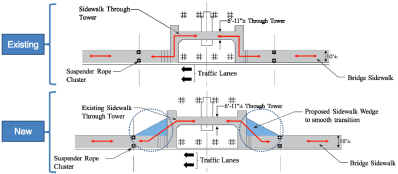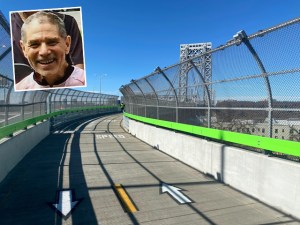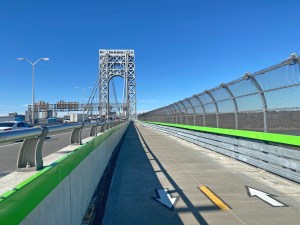The Port Authority’s Missed Opportunity to Make a Bike-Friendly GW Bridge

Next year, the Port Authority will begin a seven-year, $1.03 billion renovation of the suspension cables on the George Washington Bridge [PDF]. Announced in March 2014, the project includes new ramps to the bridge’s bike and pedestrian paths, eliminating stairs and a hairpin turn. But it won’t widen a bike path that is already too small for the amount of cycling traffic it receives.
When both paths are completed, pedestrians will be directed to the south side of the bridge, while cyclists will take the north. At eight feet wide (6.75 feet at pinch points), both paths fall short of the 14 feet preferred by the Federal Highway Administration and the 16 feet recommended by the American Association of State Highway and Transportation Officials.
Neile Weissman, a former president of the New York Cycle Club, has been campaigning to make the paths sufficiently wide. “They’re taking these paths apart and they’re putting them back together,” he said. “This is a once-in-90-years project, and they’re not building it out to modern standards.”
The George Washington Bridge gets more than 500 cyclists and pedestrians during its peak weekend hours, by Weissman’s count. And cycling on the bridge is on the rise, increasing 32 percent from 2010 to 2014, even with today’s substandard conditions.
Weissman is not convinced that the Port’s plans for separate bike and pedestrian paths will work in practice — witness the frequent presence of pedestrians on the Manhattan bridge bike path. As the number of cyclists and pedestrians crossing the bridge continues to grow, Weissman is concerned that conflicts between the two will also increase. A path less than seven feet wide at pinch points won’t be good enough.
Weissman has proposed maintaining the two existing paths for pedestrians and building two adjacent 10-foot paths for cyclists at a lower grade. He said Port Authority reps estimated his concept would cost $90 million.

Weissman has been calling on the Port Authority to adjust its plans for the paths since 2013. He’s won the support of cycling clubs, bike shops, and elected officials from across the region, including a group of 11 Congressional representatives led by Charles Rangel and Carolyn Maloney, who sent a letter to the Port Authority echoing the request for wider paths [PDF].
In the City Council, transportation chair Ydanis Rodriguez has introduced a resolution with eight co-sponsors calling on the Port Authority to widen the paths. Testifying at the Port Authority’s September 2015 board meeting, Council Member Mark Levine, who represents a part of Manhattan just south of the bridge, said that the existing paths are “not adequate, even at today’s level of usage” and argued that the recabling project was “the perfect time” to upgrade the bicycle-pedestrian facility.
When asked for comment on the bridge path plans, the Port Authority referred to a statement from Transportation Alternatives and the NJ Bike Walk Coalition supporting the project’s ADA and ramp improvements [PDF].



